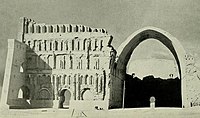Chaldean Catholic Archeparchy of Kirkuk-Sulaimaniya
The Chaldean Catholic Archeparchy of
| Part of a series on |
| Particular churches sui iuris of the Catholic Church |
|---|
|
Particular churches are grouped by liturgical rite |
|
Alexandrian Rite |
| Armenian Rite |
| Byzantine Rite |
| East Syriac Rite |
| Latin liturgical rites |
| West Syriac Rite |
Background
The Chaldean archdiocese of Kirkuk was the successor to the earlier diocese of
The last known metropolitan of Beth Garmaï is attested in the thirteenth century and the last known bishop in 1318, though the historian ʿAmr continued to describe Beth Garmai as a metropolitan province as late as 1348. It is not clear when the province ceased to exist, but the campaigns of
Yohannan Hormizd and the Chaldeans of Kirkuk

The Assyrian community of Kirkuk was still a Church of the East in sympathy in the first half of the eighteenth century. The Carmelite missionary Father Benedict visited Kirkuk on 20 May 1743, where he found 'a large number of Nestorians very ignorant of religion'. Speaking of the efforts of Catholic missionaries in the district, he said that 'there are many difficulties at Kirkuk, and few results'.[2]
The foundation of the Chaldean Catholic diocese of Kirkuk has been attributed to
Whether or not Yohannan Hormizd was able to consecrate a metropolitan for Kirkuk, the sympathies of the town's Assyrian Catholics were clearly of some significance during the power struggle between the patriarchal administrator and his opponents in the Chaldean Church and the Vatican. In 1795 the Vatican's representative Padre Fulgenzio appears to have tried to persuade the Chaldean Catholics of Kirkuk to withdraw their allegiance from Yohannan Hormizd. According to Yohannan Hormizd's own account, quoted by Badger:
Padre Fulgenzio, however, departed and went to Selook, which is Kerkook, and created divisions among the Meshihayé there, and he did the same at Ainkâwa. Moreover he wrote letters to other villages which began in this style: I, Padre Fulgenzio, superior of the Patriarchs of the East, &c.[4]
The Chaldean archbishops of Kirkuk
A stable Chaldean diocese for Kirkuk seems to have been founded by the patriarchal administrator
Lawrent Shoʿa was succeeded by Yohannan Tamraz, born in
Yohannan Tamraz was succeeded in 1883 by Joseph Gabriel Adamo of
Joseph Gabriel Adamo was succeeded by Eliya Joseph Khayyat, patriarchal vicar and titular archbishop of Nisibis since 1895 and apostolic vicar of the Chaldean patriarchate since the death of the patriarch ʿAbdishoʿ V Khayyat in 1899. He was transferred to the diocese of Kirkuk in 1900 by the new patriarch Joseph Emmanuel II Thomas, and died suddenly at Kirkuk three years later, on 2 February 1903.
Eliya Joseph Khayyat was succeeded by Theodore Msayeh, who was born in Baghdad around 1837, educated at the College of the Propaganda, and ordained a priest at Rome in 1870. He was nominated to the diocese of Kirkuk on 13 August 1904 and consecrated metropolitan of Kirkuk on 16 October 1904. He died on 26 May 1917.
Theodore Msayeh was succeeded by Stephen Jibri. He was consecrated metropolitan of Kirkuk in 1917. He died in 1952 after a reign of forty-five years.
The Metropolitans of Kirkuk during the second half of the twentieth century were Ephrem Guogue (1954–6), Rufa'il Rabban (1957–67), Gabriel Qoda (7 March 1968 – 1977) and
Louis Sako succeeded Andrew Sana as archbishop of Kirkuk on 24 October 2002. He was elected Chaldean-Catholic
Merger with Eparchy of Sulaimaniya
In July 2013, Sulaimaniya was united with the Kirkuk diocese. Yousif Mirkis was appointed as a successor to Sako in 2014, and is the incumbent.
History of Eparchy of Sulaimaniya
The Chaldean Catholic Eparchy of Sulaimaniya was a Chaldean Catholic (
Ordinaries (all apostolic administrators)
- Apostolic AdministratorEmmanuel Haddad (1976 – 1982)
- Apostolic Administrator Abdul-Ahad Rabban, Hieronymites (O.S.H.) (1982 – 1998)
- Apostolic Administrator Abbot Yousif Ibrahim, Antonian Order of Saint Ormizda of the Chaldeans (O.A.O.C.) (1999 – 2006)
- Apostolic Administrator Archimandrite Denha Hanna Touma, O.A.O.C. (2006 – 2013.07.11)
Ordinaries
- Laurent Choa (1826–1853)
- Jean Tamres (1854–1881)
- Joseph-Gabriel Adamo (1883–1899)
- Elie-Joseph Khayatt (1900–1903)
- Theodore Messaieh (1904–1917)
- Hormisdas Etienne Djibri (1917–1953)
- Ephrem Gogué (1954–1956)
- Raphael Rabban (1957–1967)
- Gabriel Koda (1968–1977)
- André Sana (1977–2002)
- Louis Sako(2002–2013)
- Yousif Thomas Mirkis (since 2014)
Population statistics
The archdiocese of Kirkuk had a population of 218 Assyrian Chaldean families, with 9 priests and 8 churches, in 1850 (Badger); 7,000 Chaldeans, with 22 priests and 16 churches, in 1896 (Chabot); and 5,840 Chaldeans, with 19 priests and 9 churches and a small Assyrian Church of the East community, in 1913 (Tfinkdji).
| Name of village | Name in Syriac | Number of believers | Number of priests | Number of churches | Name of village | Name in Syriac | Number of believers | Number of priests | Number of churches |
|---|---|---|---|---|---|---|---|---|---|
| Kirkuk | 800 | 4 | 2 | Armuta | 100 | 1 | 1 | ||
| ʿAïnqawa | 3,000 | 5 | 2 | Suleimaniya | 200 | 1 | 1 | ||
| Shaqlawa | 1,200 | 5 | 1 | Erbil | 50 | 0 | 0 | ||
| Koï Sanjaq | 200 | 2 | 1 | Rawanduz | 90 | 0 | 0 | ||
| Qorya | 200 | 1 | 1 | Total | 5,840 | 19 | 9 |
The Kirkuk district was not greatly affected by the disorders of the First World War. In 1928, according to an official statistic prepared by the Sacred Congregation pro Ecclesia Orientali, it contained seven villages, 18 priests and 4,800 believers. This statistic, collected under difficult conditions, is probably on the low side. In 1937 the archdiocese of Kirkuk contained 7,620 Chaldeans, with 19 priests and 8 churches (Kajo). The significant rise in the Chaldean population of Kirkuk and Shaqlawa since 1913 seems to have been mainly due to the resettlement of Assyrian refugees in the district during the intervening years.
| Name of village | Name in Syriac | Number of believers | Number of priests | Number of churches | Name of village | Name in Syriac | Number of believers | Number of priests | Number of churches |
|---|---|---|---|---|---|---|---|---|---|
| Kirkuk | 1,570 | 4 | 2 | Armuta | 210 | 1 | 1 | ||
| ʿAïnqawa | 3,220 | 5 | 1 | Suleimaniya | 125 | 1 | 1 | ||
| Shaqlawa | 1,890 | 6 | 1 | Erbil | 75 | 0 | 0 | ||
| Koï Sanjaq | 350 | 1 | 1 | Total | 7,620 | 18 | 8 |
References
Sources
- Baaba, Youel A. (2009). The Assyrian Homeland before World War I. Alamo, California. ISBN 978-0-9707489-6-6.)
{{cite book}}: CS1 maint: location missing publisher (link - Badger, George Percy (1852). The Nestorians and Their Rituals. Vol. 1. London: Joseph Masters.
- ISBN 9780790544823.
- ISBN 9781134430192.
- Baumer, Christoph (2006). The Church of the East: An Illustrated History of Assyrian Christianity. London-New York: Tauris. ISBN 9781845111151.
- Chabot, Jean-Baptiste (1896). "Éttat religieux des diocèses formant le patriarcat chaldéen de Babylone". Revue de l'Orient chrétien. 1: 433–453.
- Chick, H. G., A Chronicle of the Carmelites in Persia (2 vols, London, 1939)
- Fiey, J.M. (1962). Assyrie chrétienne (3 vols). Beirut.
{{cite book}}: CS1 maint: location missing publisher (link) - ISBN 9783515057189.
- Giamil, Samuel (1902). Genuinae relationes inter Sedem Apostolicam et Assyriorum orientalium seu Chaldaeorum ecclesiam. Roma: Ermanno Loescher.
- Martin, Jean Pierre Paulin (1867). La Chaldée, esquisse historique, suivie de quelques réflexions sur l'Orient. Rome.
{{cite book}}: CS1 maint: location missing publisher (link) - Tfinkdji, Joseph (1914). "L' église chaldéenne catholique autrefois et aujourd'hui". Annuaire Pontifical Catholique. 17: 449–525.
- Tisserant, Eugène (1931). "L'Église nestorienne". Dictionnaire de théologie catholique. Vol. 11. Paris: Letouzey et Ané. pp. 157–323.
- Wilmshurst, David (2000). The Ecclesiastical Organisation of the Church of the East, 1318–1913. Louvain: Peeters Publishers. ISBN 9789042908765.
- Wilmshurst, David (2011). The Martyred Church: A History of the Church of the East. London: East & West Publishing Limited. ISBN 9781907318047.


